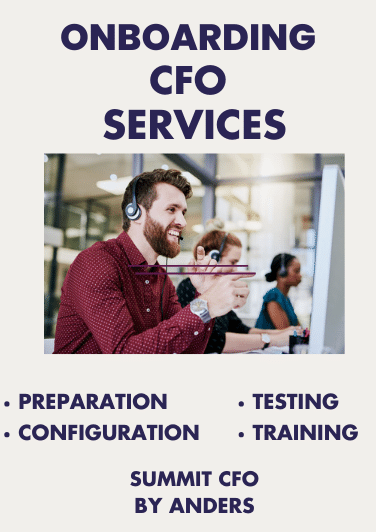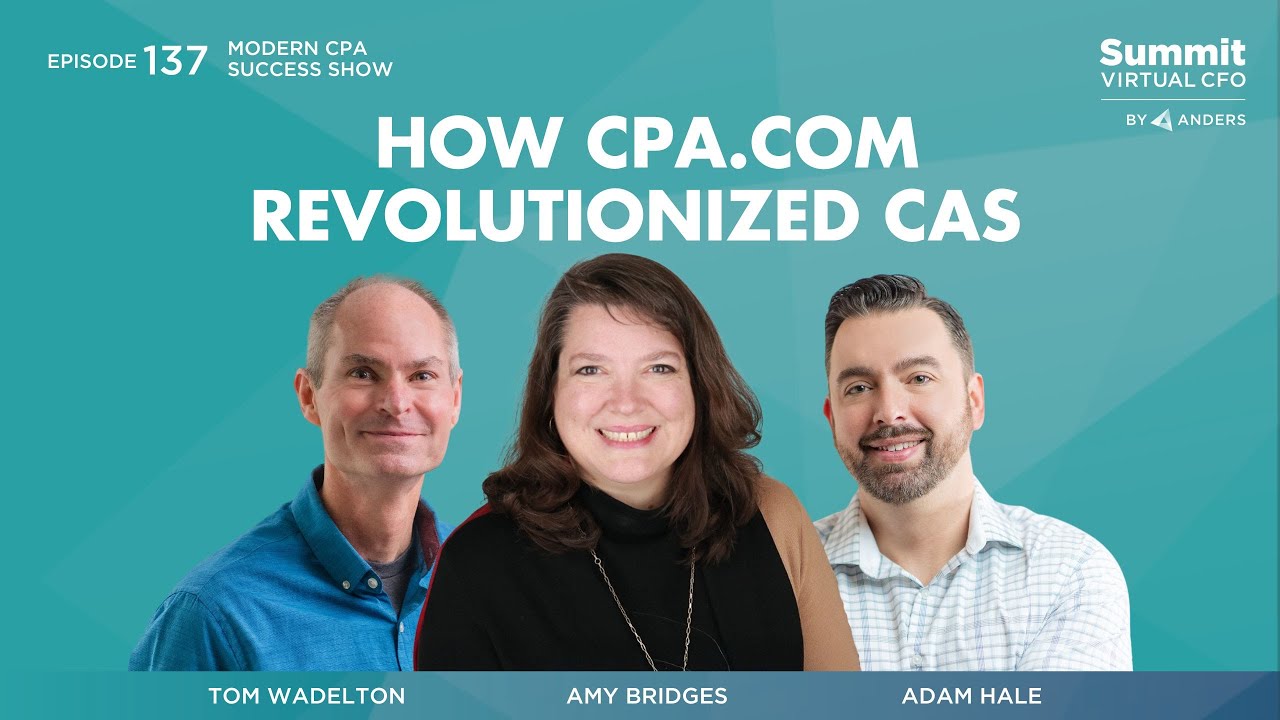We want to think about our clients as all roughly the same: We have a deliverable, a package, a forecast – all of the things that we're promising as part of our value proposition. But without the foundation of a good onboarding, it's going to be very difficult to hit all those deliverables for every client. In the same way that we’re unique as individual CFOs, they’re all unique too.
Developing an onboarding process that is consistent yet flexible has been critical to our growth as a firm. It’s evolved quite a bit over the years, but the goal has always been the same: setting the foundation for the future of that CFO-client relationship. That means ensuring good two-way communication, setting clear expectations and – above all – establishing trust.
 My role on the team – onboarding CFO – is the latest addition to Summit’s process. It wasn’t apparent that we needed the role until we solved several other crucial issues, and there was still something missing: a high-level strategist to help the permanent CFO figure out how to architect the data, leverage Summit resources, and navigate the client relationship.
My role on the team – onboarding CFO – is the latest addition to Summit’s process. It wasn’t apparent that we needed the role until we solved several other crucial issues, and there was still something missing: a high-level strategist to help the permanent CFO figure out how to architect the data, leverage Summit resources, and navigate the client relationship.
As you’re growing your firm, an onboarding team can feel like a major (even unnecessary) expense. But you can easily cover the dollar cost just by increasing client fees during the onboarding period. (We double ours for those 8-12 weeks.)
Beyond that, however, the value of onboarding far exceeds the financial cost. Done right, it allows the permanent CFO and their team to do what they were hired to do, as efficiently as possible: solve the client’s problems.
The challenge of onboarding
Onboarding is about first impressions. It’s a time when a lot of information has to change hands. We’ve got to clean up the books, understand the data, and lay the groundwork for a forecast. We’ve also got to set expectations about when and how those things will happen.
But the client has a problem – that’s why they came to us. Maybe it’s a cash flow issue, and it’s a problem right now. It’s not going to be a great start to the relationship if we tell them they need to pay us this extra fee and we won’t be back with an answer in twelve weeks.
We wanted onboarding to help solve this issue, and we knew that whatever we developed, we needed to find a scalable solution. Rather than asking the permanent team to work more during the onboarding period, we decided the best way to provide a consistent experience would be to create a separate onboarding resource.
How we built our team
The first role we added to the onboarding process was an additional senior accountant: extra hands on deck to get on top of the new financials.
But then we realized nobody was managing the entire relationship and reporting back to the client on the status. That's when we brought in a project manager – what we now call a client success manager because they have a deeper role once they get going.
So we thought, “Okay, everything's going great.” But it wasn't. Yes, we were getting the accounting done, and yes, the client was informed. But the CFO still had too much on their plate to get their deliverables across the finish line in a consistent way.
There were other challenges as well: the project manager, who doesn’t speak accountant, needed to be an overall communication link between all team members. That meant jumping into the more technical relationship of the CFO and senior accountant.
It became clear we needed a CFO to take part in onboarding: a strategist who can figure out the respective needs of each client and CFO; and a communicator who can be a conduit between the permanent CFO and the rest of the technical team.
We’re happy with the shape of our team now, but if we had to do it over, we recommend starting from the onboarding CFO position – even though it’s the most expensive of the three. The onboarding CFO can stretch to cover all the various roles: They can give the permanent CFO a second set of perspectives; and they can stretch to play the project manager or to help the permanent senior accountant.
Then, as your onboarding load starts to grow, you can add the other two positions.
The role of the onboarding CFO: providing flexibility and structure:
In broad strokes, my job helps the permanent CFO overcome a mental hurdle. They need to let go of the do-it-all-myself mindset and leverage the resources that we've put in place as a firm.
We want our CFOs to feel comfortable being a strategist and trusted collaborator, but before they can get there, we collaborate on how to architect the information: the way they want the chart of accounts to look, the conversations they want to have, the data they’re going to review – and when and how.
The specifics of the role vary. It might mean helping a newer CFO learn how the pieces of the tech stack fit together. It might mean helping them decide when to have a conversation with the client, when to push back. I work with the CFO and the client at a 10,000-foot and a granular level, to figure out the best strategy for them. We want that flexibility to adapt to the individual relationship while structuring it in a way that stays within Summit’s processes and systems.
I typically start with a conversation with the new CFO about the client's pain points so we can identify a deliverable to knock out quickly, to solve a problem and buy the team time to get the accounting cleanup done. For example, if a client has a cash flow problem, we need to find liquidity today; then we can figure out the cause and a long-term solution.
From there, I help them develop the relationship: we think about their forecast, their drivers, the relationship between non-financial and financial data, and how to work with our tech team to push that through.
As an onboarding CFO, I help with the architecture to let them know what's possible, and how they can use those resources. This has become crucial as we’ve been expanding into new verticals where the KPIs may not follow the standard templates of our bread-and-butter, service-based organizations.
Another place an onboarding CFO can be helpful is in figuring out the right time to talk to clients. Instead of just letting each CFO go with their gut (or what their client requests), I help keep consistent processes in place to help avoid creating needless complications in the client relationship.
Collaboration between the onboarding and permanent teams
Our onboarding team essentially duplicates the permanent team, so we want to be very clear about the roles of each.
Originally, we had our teams assigned to opposite tasks: one was responsible for going backwards – housekeeping of historical data – and the other one, forwards: focusing on strategy and forecasting.
But it’s impossible to provide sound forecasting without sound data, so that approach ended up generating confusion and unrealistic expectations.
Instead, we decided to keep one team, one focus, and instead break up the process into phases: phase one is architecture and data cleanup. We open the walls, check out the plumbing, and provide a schedule for how long exactly onboarding should take. In phase two we dive into consulting conversations and get the forecast running.
This breakdown keeps the permanent CFO out of the line of fire. The client knows to expect that the high-level strategy will be a bigger part of the conversation starting in phase two. But we also make sure to listen to their needs and take a consultative from the get-go, based on the kinds of insight we can start to provide before the data is cleaned up.
What does a good onboarding CFO look like?
Since the job of a CFO is to move between consultative and detailed-oriented work, your ideal candidate will be as comfortable in the weeds as they are up in the clouds.
However, if that kind of player does not exist on your current bench, that’s okay. As a firm, you can create the kind of processes and support the onboarding CFO needs, to balance their default perspective. If you’re training a CPA to do this job, they will likely be more granular and less adept at zooming out. If you’re hiring someone with a business strategy background, they will likely be focused on the 10,000-foot perspective and less familiar with the weedy details.
Keep in mind: While it might seem like you have to put your most experienced team member in this role, it’s also possible to train a more junior person, as Summit did with me.
In an ideal world, you would take a page out of the Texas Tech Quarterback Room playbook. (Stay with me for a second, non-football fans.) Have four quarterbacks on your team: a freshman, a sophomore, a junior, and a senior who have spent time in the system. When it's their time, they know the playbook, they know the rules, they know all the reads. At that point, it's just about getting them out there and executing. It becomes a natural pipeline for developing versatile, strategic CFOs.
What does successful onboarding look like?
When I leave the permanent team behind, I want to see a good connection between the CFO and the client. I want to see that the client listens to the CFO and actually uses the forecast to make decisions. I want to see the CFO feeling comfortable as their coach and their cheerleader – but also feel confident pushing back, when they need to have a difficult conversation.
We know the forecast is going to change over time. But if you have a wonderful relationship, that is going to make the CFO sticky. That's the secret sauce that separates a true advisor from someone who's just looking at the books.
I also see onboarding as a success when our CFOs and senior accountants feel more confident, better prepared, more aware of the resources available to them. That means new employees are learning faster, and clients will continuously receive a better level of service.
Remember, each onboarding is an opportunity to find out what’s working. At the end of the process, I collect feedback from both sides. We’ve been developing our approach for years – which is proof that this is an adaptable, scalable process. It’s not all-or-nothing. Start with a single onboarding specialist, and then grow your team as you grow your practice.
Now that we’ve developed the role of onboarding CFO, it feels like our onboarding has clicked into place. There will always be places to improve, but we’re seeing the benefits on the side of the clients and our internal team.
Want to learn more about how we offer Virtual CFO services to our clients? Discover our playbook:
.png?width=120&height=77&name=Summit-Virtual-CFO_color_rgb%20(1).png)














